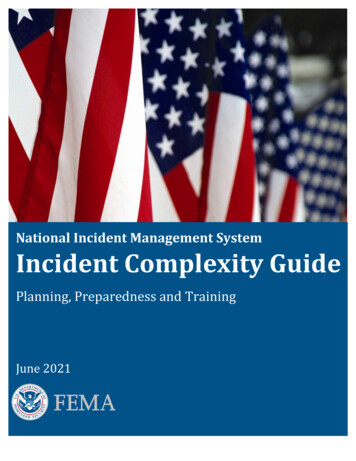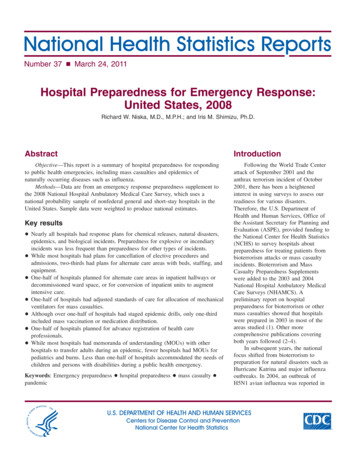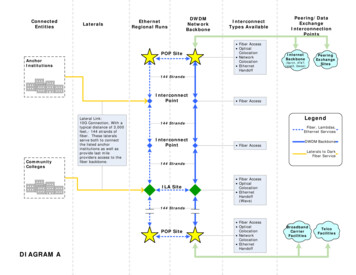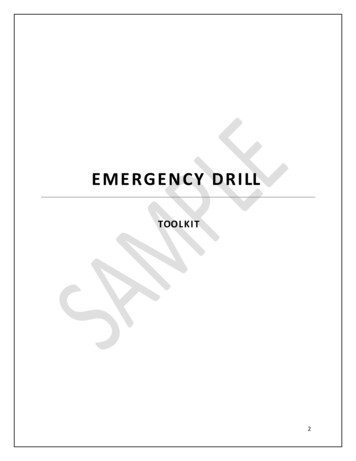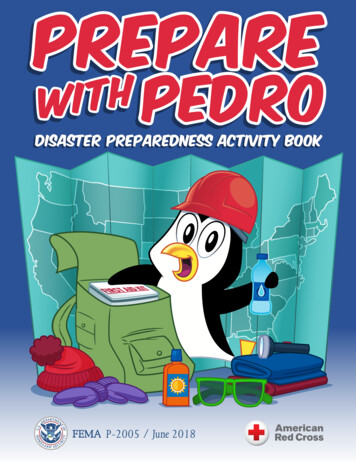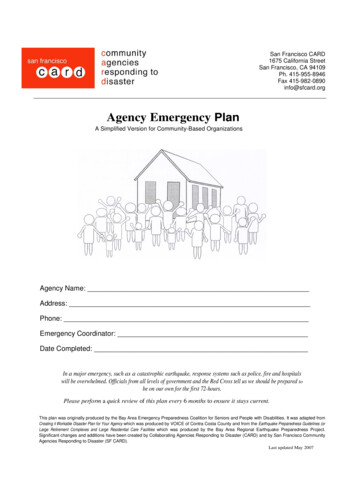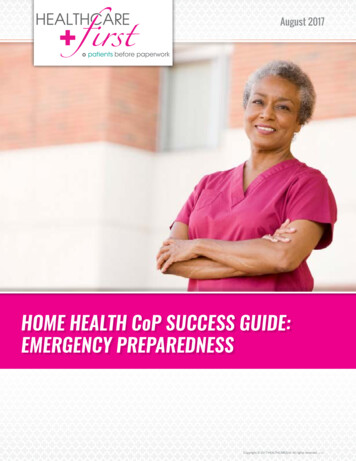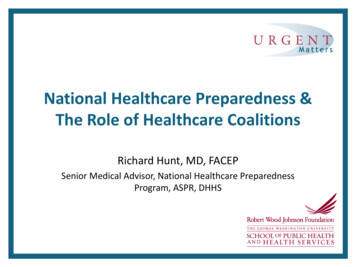
Transcription
National Healthcare Preparedness &The Role of Healthcare CoalitionsRichard Hunt, MD, FACEPSenior Medical Advisor, National Healthcare PreparednessProgram, ASPR, DHHS
The Meningitis Outbreak and the National HealthcarePreparedness Programs The story of “Healthcare Coalitions and the Case of the Michigan MeningitisOutbreak” National Healthcare Preparedness ProgramsOffice of the Assistant Secretary for Preparedness and Response (ASPR)U.S. Department of Health & Human Services Leading role in ensuring healthcare systems preparedness Cooperative agreements provide approximately 350M annually to 50 states, fourlocalities and eight U.S. territories for building and strengthening their abilities torespond to incidents
National Guidance for Healthcare System PreparednessNational Healthcare Preparedness Programs, January 2012 ASPR has identified the following eight capabilities as the basis forhealthcare coalition preparedness:––––––––Healthcare System Preparedness (Healthcare Coalition Development)Healthcare System RecoveryResponder Safety and HealthEmergency Operations CoordinationMedical Surge (Immediate Bed Availability)Fatality ManagementInformation SharingVolunteer Management
A Strong FoundationHealthcare SystemPreparedness(Health Care Coalitions)4
Healthcare Coalitions Build community partnerships to support health preparedness Assist emergency management and ESF#8 with preparedness, response,recovery and mitigation activities Assists with resource coordination and patient movement by coordinatingand sharing incident specific healthcare situational awareness Enables effective medical surge and serves as anchor for Immediate BedAvailability
Healthcare Coalitions Alternative Care Sites Hospitals Behavioral Health Long Term Care Facilities Community Based Organizations National Disaster Medical System Community Health Centers Primary Care Providers Dialysis Facilities Public Health Emergency Management Private Insurance Emergency Medical Services Urgent Care Facilities Faith Based Organizations Volunteers
Healthcare Coalitions“The whole is greater than the sum of its parts.”Aristotle
Healthcare Coalitions and the Meningitis Outbreak Coalitions . But what role do they have when there isn’t any declared disaster? Response to meningitis outbreak exemplifies value of coalitions Real world example of success at many levels: local, state, federal Weaving threads of preparedness into the daily delivery of care “If we can’t do it everyday, we can’t do it on game day”
When Needs Exceed Resources: HealthcareCoalitions’ Response to the MeningitisOutbreakLinda Scott, R.N., BSN, MAHospital Preparedness Program Manager,MDCH OPHPJenny Atas, M.D., FACEPMedical Director,Region 2 South Healthcare CoalitionDebra PhillipsEmergency Management Coordinator, St. JosephMercy Hospital
MI Public Health and HealthcareEmergency Preparedness Program
MI Emergency Management SystemDHS/FEMAPresidentGovernorMichigan State PoliceState Director of EMSEOCMSP EMHSDMDCH/CHECCHealthcareCoalitionsEMHSD DistrictCoordinatorsAll Emergencies /Disasters Start LocalLocal EmergencyManagementLocal HealthDepartments
OPHP The Office of Public Health Preparedness (OPHP) in the MichiganDepartment of Community Health (MDCH) was established in2002 to coordinate development and implementation of publicand medical health services for preparedness and response toacts of bioterrorism, infectious disease outbreak and other publichealth emergencies. The mission of the office has expanded toencompass "all hazards" preparedness and response. Funding for the program is provided exclusively through twofederal cooperative agreements: the Centers for Disease Controland Prevention’s Public Health Emergency Preparedness Programand the Office of the Assistant Secretary for Preparedness andResponse’s Hospital Preparedness Program.
ASPR & CDC Cooperative AgreementFiduciary MCA8 Regional Healthcare CoalitionsHealthcare OrganizationsLocal Health DepartmentsTribes / Other PartnersCoordinated Local, Regional andState Planning
MCA - an organization designated by Michigan Departmentof Community Health, EMS Office under Part 209 of PA 368of 1978– Responsible for supervision, coordination of emergency serviceswithin a specific geographic area through State approved protocols Each hospital w/ED must be given opportunity to participatein a MCA Medical Director of MCA– board certified in EmergencyMedicine/ACLS & ATLS certified Fiduciary for Healthcare Coalitions
Michigan (8) Healthcare Coalitions 83 Counties45 Local Health Dept.12 Federally Recognized Tribes110 Emergency Mgmt. Programs191 Hospitals440 LTC facilities800 Life Support Agencies 300 FQHC,MHC,RHC
Medical Surge Capacity and Capability
Each Coalition has the following:– Medical Director– Regional Healthcare Coordinator– Assistant Healthcare Coordinator– Emergency Preparedness Coordinators RegionLHD within– Regional Epidemiologist– District Emergency Management Coordinator
Region 2 South (R2S): Monroe, Washtenaw, & Wayne County– Includes the City of Detroit Smallest geographically, but serves 25% ofMI’s population and houses the mosthealthcare facilities and EMS agencies
Canadian RepresentativesDMAT/ NDMSHospital RepresentativesEmergency ManagementEMS (Fire and Private)FQHCsHealth DepartmentsIndustry ( BC/BS, GMCompuware )Law Enforcement (Local,Sheriff and FBI)LEPCsLong Term Care sitesMCAs Medical ExaminerMMRSPoison Control(LHD within Region) PublicHealth AuthoritiesImmunization CoordinatorEpidemiologistStrategic National StockpileCoordinatorPublic InformationPublic SafetyRed Cross
R2S Advisory Board Subcommittees CommunicationEmergency ManagementHealthcare PreparednessExercisePediatricsPharmacyPublic HealthPublic InformationMental HealthEMSLong Term CareEducation/ Training
Improved “all-hazard” emergency preparedness– Established regional portable gas spectrum analyzer and 24/7 operationalresponse team as a resource for hospital and pre-hospital facilities.– Provided funding to hospitals to procure needed equipment, supplies, andtraining (unique to each facility).– Developed emergency plans and procedures that facilitate a coordinatedhealth care response to any disaster (natural, man-made or intentional).– Purchased (and maintains) medical supplies and equipment for AlternateCare Centers (ACCs) and Neighborhood Emergency Help Centers (NEHCs).
Improved “all-hazard” emergency preparedness– Purchased (and maintains) medical supplies and equipment for Mass CasualtyIncidents (MCI).– Hosted educational conferences.– Established (and maintains) statewide asset of a 100-bed mobile field hospital(MI-TESA Medical Unit).
Improved CBRNE (Chemical, Biological, Radiological, Nuclearand Explosive) emergency preparedness– Established caches for CBRNE incidents in hospital pharmacies.– Coordinated the regional implementation of the CHEMPACK &MEDDRUN programs.– Assisted in the coordination of regional planning to implement theStrategic National Stockpile (SNS).– Establishing radiological monitoring equipment at hospitals.– Funded the establishment of antibiotic and antiviral stockpiles at hospitalsto protect hospital staff.– Funded the establishment of antibiotic and antiviral stockpiles forpublic health department staff.
Early October 2012: CDC reports multi-state investigation of FungalMeningitis patients that received an epiduralsteroid injection– Report stated 35 cases in 6 states None of the initial case were reported in MI– Four MI facilities identified as receiving contaminated lotnumbers– Facilities began contacting and advising all patients thatreceived contaminated lots for possible symptoms
The geographical locations of thefour identified facilities in theCDC report that received thecontaminated lots
CDC released updated report alerting that allinjectable products from the New EnglandCompounding Company (NECC) dated after May 21,2012 were recalled.– Patient outreach calls expanded from contaminated lotrecipients to patients that received any NECC products.
October 2012: St. Joseph Mercy Hospital (SJMH) in Ann Arbor, MIreported a large number of patients presenting.– Most required diagnostic lumbar punctures– Many patients admitted due to positive findings– Influx would be handled internally - no additionalresources needed Hospital opened a clinic in a closed wing of the facility Open dialoged with R2S and SJMH to maintain awareness andoffer support if needed
Due to the location, SJMHbecame the referral site forpatients who requireddiagnostic testing or carerelated to the recalled product
November 7, 2012: SJMH requested assistance identifying additional staffingresources from R2S– R2S coordinated a conference call between MDCH, SJMH, and R2N todiscuss options– MDCH was able to identify 95 volunteers that met the criteriarequested on the MI Volunteer Registry Within 24 hours, MDCH re-verified medical credentials and conductbackground checks of the identified volunteers
(Staffing Resources, continued)– SJMH affiliated hospital, located in Ohio, was willing tosend staff, but were not licensed to work in MI– MDCH worked with the licensing agency to grant a MIlicense within 24 hours of receipt of appropriatecredentials of the identified Ohio staff
While staffing resources were established, thepatient profile began evolving– Patients begun developing abscesses at the injection site– More complex diagnostic testing, treatment, and muchlonger patient stays in the facility Each symptomatic and asymptomatic patient required a MRI toscreen for abscesses MRI results – extremely subtle
November 9, 2012: SJMH contacted R2S with their potential need forregional hospital assistance– R2S and Region 2 North (R2N) identified regional hospitalsthat were capable of caring for these patients– Hospitals were required to have: Neurosurgery, Neurology,Intensivist, MRI capability, Infectious Disease, and ClinicalPharmacy specialists
(Hospital Assistance Request, Continued)– R2S and R2N began gathering contact information for thefacility’s CEO, CMO, and COO– MDCH, through R2S and R2N, distributed a formal requestto the identified contacts for assistance with patient careand established the 24 hr POC for each facility– All capable R2S hospitals responded to the request willingto assist with their current bed availability
R2S coordinated daily conference calls betweenSJMH, R2S, R2N, and MDCH– R2S took the lead on developing a coordinated andconsistent update to the R2S facilities, R2N, and MDCH Updates were sent to hospital’s Facility Liaison and points ofcontact (POC) R2S and R2N used the daily updates to distribute the evolvingpatient care guidelines to all facilities
November 13, 2012: SJMH noted the alarming number of asymptomaticpatients with positive findings on their MRIs– Of 7 asymptomatic patients screened that day, 5 werepositive for abscesses– SJMH staffed a call center to continue patient outreach tothose at risk and schedule MRIs Roughly 400 additional patients needing MRIs MDCH sent additional staff to assist 11-19-12 to 11-23-12
(Patient Results, Continued)– R2S and R2N continued to collect updatedhospital census data to prepare for potentialtransfers from SJMH– From the data, R2S gave SJMH a “menu” offacilities that could be presented to patientsrequiring transfer
November 14, 2012: SJMH able to care for the 70 patients admitted, butpharmacy needed assistance– Pharmaceuticals used to treat required complexcompounding– SJMH requested additional Pharmacy Technician supportfrom R2S– R2S and R2N forwarded the request to the PharmacySubcommittees and Facility Liaisons
(Pharmacy Technicians Assistance, continued)– Through this distribution, SJMH was able toschedule enough temporary staff to sustainoperations through 2012
November 16, 2012: SJMH confirmed that patients were transferred tothe facilities identified by R2S and R2N– With 79 patients admitted related to the outbreak, SJMHbegan utilizing the “menu” of available treatment centers– SJMH coordinated with R2S and MDCH to host weeklywebinars– Patient care standardized between facilities
(Patient Transfers, Continued)– The weekly webinars provided clinical updates anddiscussed specific patient cases– The webinar information was distributed to the regionalfacilities, the Regional Healthcare Coalitions statewide,and MDCH Hospitals expecting to receive patients were encouraged todistribute the webinar information to their Infectious Diseaseprofessionals, Neurosurgery department, Hospitalists, and NursingDirectors
November 16, 2012: SJMH overwhelmed with number of patientspresenting in the Emergency Department (ED)– Most of the ED patients were unrelated to theMeningitis outbreak– R2S contacted regional hospitals to requestassistance in receiving SJMH ED visits All were willingBed data collectedR2S provided information to SJMHfacilitate transfersto
November 26, 2012: SJMH began discharging patients related to theoutbreak– MRI scans still ongoing, beginning to return morenegative results Roughly one-third of the patients were positive for epiduralabscessesCDC adopted and distributed the MRI guidelines developedinternally by SJMH– Daily conference calls were scaled back to once per week
January 10, 2013: SJMH had 17 inpatient cases related to theoutbreak in the facility– Roughly 175 patients were treated at SJMH– All of the 600 patients requiring a MRI scan had beencontacted and scheduled Of the remaining patients to have scans conducted, 10 wereadmitted for abscess treatment– SJMH began working with the CDC to develop follow-upcare guidelines
Michigan Patient Summary as ofFebruary 7, 2013– 243 Meningitis cases were treated– 154 patients requiring treatment for onlyabscesses were seen– 41 patients requiring treatment for both,Meningitis and abscesses, were treated– 12 deaths resulted from the outbreak in MI
All Disasters Local– In healthcare, all disasters begin locally– Activation of hospital incident command toconsult w/internal resources Clinical Staff – Physicians and NursesInfectious DiseaseEmergency CenterClinical Labs and Pharmacy
All Disasters Local (continued)– Pooling of hospital and as needed, systemresources– Consult as needed w/applicable agency(ies), i.e.CDC– Effectively manage event internally
Second Wave – Fungal Infections– Increased volume of meningitis patients & thosere-presenting w/epidural abscesses nearinjection site– MRIs and surgeries escalated– Experiencing capacity issues, i.e. opening ofclosed unit/24-hour care, resources stretched andtiring
Beyond Our Walls– Administrative decision made to dialogue w/R2South Medical Director, Dr. Atas– System facilities active members of R2S– Region a rich reservoir of knowledge & resourcesof healthcare agencies– Access to OPHP & MDCH
Beyond Our Walls (continued)– Prior engagement w/R2S occurred 2011 Patient presented to ED after swallowing rat pellets Off-gassing of pellets resulted in activation of countyhazmat team Prompted a call to Region 2 South for regionalperspective & support
Beyond Our Walls (continued)– Dr. Atas provided consult, dialogue with otherhospitals & connection with State Poison Control– That successful interaction indicated connectingwith R2S a reasonable “next step.”
Dialogue with R2S, 2N & OPHP/MDCH– Call to Dr. Atas, in consult w/Linda Scott providedopportunity to dialogue– Response was immediate, prompting search forvolunteers (nurses, pharmacy techs)– MDCH assisted w/Ohio licensing & consult,support for meningitis clinic
Dialogue with R2S, 2N & OPHP/MDCH(continued)– Coordinated information to R2S facilities– Facilitated distribution of patient care guidelines– Collected hospital census data– Provided list of facilities accepting patienttransfers– Planned/promoted weekly webinars toinform on standardized care
Regional Healthcare Coalition –Aid Beyond Conception– Connecting w/Regional Healthcare Coalitionprovided support in a single event/single facility“real life” crisis, utilizing regional and statesupport as needs unfolded– Aid beyond original conception
Questions?
Linda Scott, R.N., BSN, MAScottL12@michigan.govJenny Atas, M.D., F.A.C.E.P.JAtas@dmc.orgDebra Phillipsphillid2@trinity-health.org
CME Disclosure StatementACCREDITATION:The George Washington University School of Medicine and Health Sciences is accredited by the AccreditationCouncil for Continuing Medical Education to provide continuing medical education for physicians.PHYSICIAN CME CREDIT:The George Washington University School of Medicine and Health Sciences designates this continuing medicaleducation activity for a maximum of 1.5 AMA Physician Recognition Award Category 1 Credits .Disclosure:All speakers and planners submitted disclosures of relevant commercial relationships prior to this event. Noneofthe speakers or planners had any relevant financial relationships to report upon disclosure.AcknowledgementsThis activity did not receive commercial support
The story of "Healthcare Coalitions and the Case of the Michigan Meningitis Outbreak" National Healthcare Preparedness Programs Office of the Assistant Secretary for Preparedness and Response (ASPR) U.S. Department of Health & Human Services Leading role in ensuring healthcare systems preparedness



